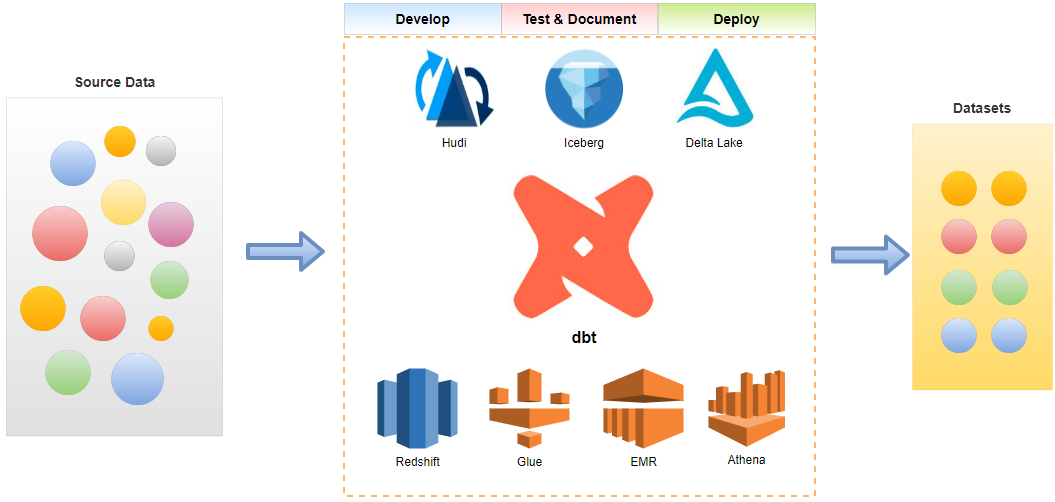The data build tool (dbt) is an effective data transformation tool and it supports key AWS analytics services – Redshift, Glue, EMR and Athena. This series discuss how to integrate dbt with those AWS services as well as popular open source table formats.
In our experience delivering data solutions for our customers, we have observed a desire to move away from a centralised team function, responsible for the data collection, analysis and reporting, towards shifting this responsibility to an organisation’s lines of business (LOB) teams. The key driver for this comes from the recognition that LOBs retain the deep data knowledge and business understanding for their respective data domain; which improves the speed with which these teams can develop data solutions and gain customer insights. This shift away from centralised data engineering to LOBs exposed a skills and tooling gap.
Let’s assume as a starting point that the central data engineering team has chosen a project that migrates an on-premise data warehouse into a data lake (spark + iceberg + redshift) on AWS, to provide a cost-effective way to serve data consumers thanks to iceberg’s ACID transaction features. The LOB data engineers are new to spark and they have a little bit of experience in python while the majority of their work is based on SQL. Thanks to their expertise in SQL, however, they are able to get started building data transformation logic on jupyter notebooks using pyspark. However they soon find the codebase gets quite bigger even during the minimum valuable product (MVP) phase, which would only amplify the issue as they extend it to cover the entire data warehouse. Additionally the use of notebooks makes development challenging mainly due to lack of modularity and failing to incorporate testing. Upon contacting the central data engineering team for assistance they are advised that the team uses scala and many other tools (e.g. Metorikku) that are successful for them, however cannot be used directly by the engineers of the LOB. Moreover the engineering team don’t even have a suitable data transformation framework that supports iceberg. The LOB data engineering team understand that the data democratisation plan of the enterprise can be more effective if there is a tool or framework that:
- can be shared across LOBs although they can have different technology stack and practices,
- fits into various project types from traditional data warehousing to data lakehouse projects, and
- supports more than a notebook environment by facilitating code modularity and incorporating testing.
The data build tool (dbt) is an open-source command line tool and it does the T in ELT (Extract, Load, Transform) processes well. It supports a wide range of data platforms and the following key AWS analytics services are covered – Redshift, Glue, EMR and Athena. It is one of the most popular tools in the modern data stack that originally covers data warehousing projects. Its scope is extended to data lake projects by the addition of the dbt-spark and dbt-glue adapter where we can develop data lakes with spark SQL. Recently the spark adapter added open source table formats (hudi, iceberg and delta lake) as the supported file formats and it allows you to work on data lake house projects with it. As discussed in this blog post, dbt has clear advantages compared to spark in terms of
- low learning curve as SQL is easier than spark
- better code organisation as there is no correct way of organising transformation pipeline with spark
On the other hand, its weaknesses are
- lack of expressiveness as Jinja is quite heavy and verbose, not very readable, and unit-testing is rather tedious
- limitation of SQL as some logic is much easier to implement with user defined functions rather than SQL
Those weaknesses can be overcome by Python models as it allows you to apply transformations as DataFrame operations. Unfortunately the beta feature is not available on any of the AWS services, however it is available on Snowflake, Databricks and BigQuery. Hopefully we can use this feature on Redshift, Glue and EMR in the near future.
Finally the following areas are supported by spark, however not supported by DBT:
- E and L of ELT processes
- real time data processing
Overall dbt can be used as an effective tool for data transformation in a wide range of data projects from data warehousing to data lake to data lakehouse. Also it can be more powerful with spark by its Python models feature.
